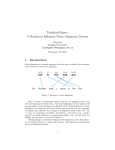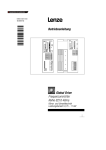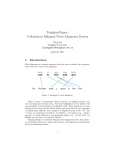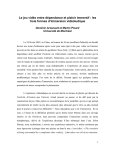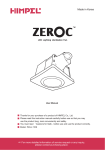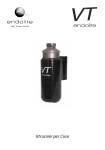Download Photon Testreport Fronius IG TL 5.0
Transcript
science & technology | inverters | test The Solar Power Magazine International A 96.2 % at high irradiation 9/2010 www.photon-international.com The Solar Power Magazine Fronius submitted a device from its first transformerless inverter series to PHOTON Laboratory for testing – and the IG TL 5.0 made a very good impression International F A 95.9 % at medium irradiation* 9/2010 www.photon-international.com * when measured with increasing DC powers (see MPPT adjustment efficiency section), the PHOTON efficiency was 95.7 percent, but that also suffices for an A grade Highlights • The IG TL 5.0 is a transformerless inverter with a DC nominal power of 4,730 W • The MPP range stretches from 350 to 700 V • The unit’s maximum conversion efficiency comes in at 98 percent; the European efficiency is 97.4 percent, while the Californian efficiency is 97.5 percent • The PHOTON efficiency is 95.9 percent at medium irradiation with decreasing DC power, but 95.7 percent with increasing DC power; it hits 96.2 percent at high irradiation • The unit’s IP 55 protection type, and low dependence on operational and ambient temperatures allow for installation in a variety of locations 156 A successful debut ronius International GmbH, based in Wels, Austria, presented its first transformerless inverter at the European Intersolar trade fair in June 2009. Then, after 6 months, four devices from the company’s IG TL series finally hit the market. The company attributes the delay to the inverters being in a »test phase.« However, it seems more likely that Fronius, like all inverter manufacturers at that point, was suffering from supply issues for important components. The IG TL 5.0, which PHOTON Laboratory received in March after Fronius completed the usual test agreement, was definitely one of the first of its kind to hit the lab’s test bench. While this device marks Fronius’ entry into the ranks of manufacturers offering transformerless devices, the IG TL series is host to a number of other innovations as well. The device is divided into two separate parts: the front unit with the power electronics can be removed from the rear section without dismantling the AC and DC connections – hardly a conventional design. Furthermore, the datasheet promises excellent performance, which naturally piqued curiosity at PHOTON Lab about how well this newcomer would perform during tests. Construction The IG TL series consists of the IG TL 5.0 with 4,600 W of AC nominal power, the IG TL 3.0 with 3,000 W, the IG TL 3.6 with 3,600 W, and the IG TL 4.0 with 4,000 W. All four models in the range are transformerless, and are identical in terms of construction, dimensions and weight. The test candidate has a well-arranged construction and appears simple to manufacture. The first thing installers are likely to notice is the unusual concept for attaching the unit to the wall and hooking the unit up electrically: the wall bracket has an integrated connection area with terminal blocks. The connectors that attach to the blocks are located on the bottom of the power element’s box. Therefore, when installing the unit, first the wall bracket is installed, and then the connectors are attached to the clamps integrated in the bracket. The actual inverter is located in a box that is inserted onto the wall bracket via four tracks, and then latched into the terminal blocks. Finally, the two separate pieces are secured together using six screws. The goal of this construction is to facilitate service and maintenance. For most repairs, the device’s core can be removed from the bracket and replaced with a substitute (for instance, a device with a new circuit board). The box with the device’s central unit has its own cover. Once removed, the inside of the inverter is on display. At the bottom, a filter circuit board holds the power connections, the DC- and AC-side EMI filters, as International September 2010 90 90 83 83 76 76 68 62.8 57.8 68 62.8 60 57.8 60 52 52 44 photon-pictures.com (3) 44 36 36 28 28 20 20 The rear section of the IG TL 5.0, which is attached to the wall, contains the connectors and a slot for the communications circuit board. The box with the actual inverter is then inserted into this section. Thermographic images showed no problematic temperatures. well as six string fuses. The power circuit board, which also contains the control unit, is located on a higher level and is connected to the filter circuit board. Soldered underneath the power circuit board is a transistor module, the heat losses from which are directed away via a small cooling element situated below the box. The buck converter’s and the sinusoidal filter’s chokes are located above the power element circuit board cast in a cartridge inside the box. There is a small, DC-powered fan for distributing heat inside the box on the same level as the circuit boards. A DC circuit breaker is mounted at the bottom of the device, on the unit that attaches to the wall. There is also a plug-in box for the communications circuit board. The housing therefore consists of three pieces: the wall bracket, the central unit made of molded plastic and the cover made of aluminum sheeting. The device has an IP 55 protection type and is therefore suitable for installation outdoors, if protected from the elements. Both the small internal fan and the cooling element fan are easy to remove or exchange in the event of a malfunction. The cooling element fan is subjected to surrounding conditions and can therefore clog if operated in a dirty location. In total, six string cables and three grid cables are fed into the housing and directly attached to the terminal block. All of the International September 2010 cables are internally strain-relieved. To ensure safe operation, the unit offers grid monitoring with all-pole-sensitive residual current protection and DC-side insulation monitoring, according to the German DIN VDE 0126-1-1 norm. The grid is checked for correct impedance, voltage, frequency, and an appropriate DC share in the AC current, while residual-current monitoring is carried out based on absolute values and changes in amplitude. An insulation test on the solar generator, which occurs prior to each connection to the grid, checks the resistance between the generator’s connections and the ground. An unusual feature of the IG TL inverter is that it continually aligns and analyzes the current of attached strings. The electrolytic capacitors in the power element have a temperature class of 105 °C and are therefore well-designed to handle ambient temperatures. The device’s status is shown with a display and three LEDs. The inverter is equipped with one USB port, a 12 V signal output, as well as a Solar Net input and output. Software updates are easy to install: a new version can simply be downloaded from Fronius’ website onto a USB stick and then transferred to the device via the USB port. The Solar Net connections are used to integrate the unit into Fronius’ Datcom system, for instance, to communicate with additional inverters, or irradiation and temperature sensors. The 12 V signal output (normally open contact) is available for connecting audible alarms, visual signals or installation relays. Operation The device arrives at the customer’s home well packaged and protected in two Styrofoam molds. Mounting the wall bracket, which contains the connection area, and inserting the power element is simple enough. At 19.1 kg, the IG TL 5.0 is rather light. As long as the solar generator is properly designed and the internal DC disconnect is switched on, the inverter can begin operation. It took about 52 seconds to run a series of tests before connecting to the grid. The display is level with the front cover, has orange backlighting and is easy to read. The menu language is available in German or English, and the addition of other languages is planned. The display is activated as soon as grid voltage is present and turns off if the device isn’t used for 2 minutes. In the set-up menu, users have the option of setting the display lighting to turn on or off for extended periods of time. The unit’s four buttons can be used to set a variety of parameters. The display offers access to a lot of data and is clearly structured. In addition to various status and error messages, the unit’s 157 science & technology | inverters | test = = sjmm=áå=s At different input powers – beginning with the highest values and decreasing to the lowest possible values – the IG TL 5.0 reaches a consistent adjustment efficiency of above 99 percent. = Overall efficiency sjmm=áå=s The MPP tracker’s consistent operation (with decreasing DC power) results in an overall efficiency path that is almost identical to that of conversion efficiency, though at a slightly lower level. OM PM ηpìã=áå=B NMM VR VM UR UM TR TM NM OM PM TMM SUO SSP SQR SOS SMU RUV RTN RRP RPQ VR RNS QVT QTV VS QSN QQO QOQ VT QMR PUT PSU PRM NM OM PM QM RM SM TM UM B=kçãáå~ä=éçïÉê=EmjmmF VM NMM NNM B NMM VU VS VQ VO VM UU US UQ UO UM TU TS TQ TO TM M NOM s NIMMM = UMM SMM QMM = TMM SUO SSP SQR SOS SMU RUV RTN RRP RPQ VV RNS QVT QTV QSN QQO QOQ QMR PUT PSU PRM NM QM RM SM TM UM VM NMM NNM NOM OMM M M O Q S = QM RM SM TM UM B=kçãáå~ä=éçïÉê=EmjmmF VM NMM NNM U NM NO ât TMM SUO SSP SQR SOS SMU RUV RTN RRP RPQ RNS QVT QTV QSN QQO QOQ QMR PUT PSU PRM NOM TM TR UM UR VM VR NMM ηpìã=áå=B = × MPPT adjustment efficiency (decreasing power) 158 = sjmm=áå=s The IG TL 5.0 reaches its highest value at lower MPP voltages; beyond around 424 V, the buck converter is activated, resulting in losses in efficiency. η áå=B s NIMMM NMM VR UMM VM SMM UR QMM UM aáÉëÉå=qÉñí=ìåÇ=ÇÉå=o~ÜãÉå=ê~ìëåÉÜãÉåK=aÉê=o~ÜãÉå=áëí=NNIQ=Åã=ÄêÉáíI=~äëç=ëç=ÄêÉáí=ïáÉ=ÇáÉ OMM TR O=pé~äíÉå=áã=eÉÑí=ìåÇ=áå=ÇáÉëÉê=dê∏≈É=ëçää=Ç~ë=aá~Öê~ãã=~ÄÖÉÇêìÅâíI=~äëç=Ç~ë=aá~Öê~ãã=åáÅÜí=òççãÉå M TM M O Q S U NM NO ât NM OM PM QM RM SM TM UM VM NMM NNM NOM B TMM TMM NMM SUO SUO VU SSP SSP VS SQR SQR VQ SOS SOS SMU SMU VO RUV RUV VM RTN RTN UU RRP RRP RPQ US RPQ VR RNS RNS UQ QVT QVT UO QTV QTV VS UM QSN QSN QQO QQO TU QOQ QOQ TS VT QMR QMR TQ PUT PUT TO PSU PSU PRM PRM TM NM OM PM QM RM SM TM UM VM NMM NNM NOM TM TR UM UR VM VR NMM M η áå=B B=kçãáå~ä=éçïÉê=EmjmmF = Conversion efficiency B NMM VU VS VQ VO VM UU US UQ UO UM TU TS TQ TO TM M International September 2010 sjmm=áå=s TMM SUO SSP SQR SOS SMU RUV RTN RRP RPQ RNS QVT QTV QSN QQO QOQ QMR PUT PSU PRM B NMM VU VS VQ VO VM UU US UQ UO UM TU TS TQ TO TM M VV VU NM OM PM QM RM SM TM UM B=kçãáå~ä=éçïÉê=EmjmmF »present« mode shows the following values: fed-in power, grid voltage, output current, grid frequency, and generator voltage and current. Using a Fronius Sensor Box, users can also access data on module temperature, ambient temperature and irradiation values. The time and date are also displayed. The device also has a »today« mode, in which the display informs users about oper- VM NMM NNM NOM ating duration, fed-in energy, the monetary value of the achieved yield – whereby the tariff level is entered by the operator, choosing the applicable currency from over 20 different countries available worldwide – and an estimated value for CO2 savings, as well as the maximum value for output power, grid voltage and generator voltage. In conjunction with the Sensor Box, users can access MPPT adjustment efficiency (increasing power) If different power values are applied, progressing from low to high powers, the IG TL 5.0’s MPP tracking precision decreases, particularly at lower powers and voltages. This causes the PHOTON efficiency to decrease slightly. data on the maximum and minimum values for module and ambient temperatures, as well as the maximum irradiation value. Instruction manual The device also includes a very comprehensive and informative user’s manual. It applies to all units in the IG TL range. In ad- Qinhuangdao Donwoo Electronic Co.,Ltd, which registered for setting up in 2005, is the specialization company on manufacture the welding ribbon of the Solar PV modules. The engineers of Donwoo are all the experts in the field of PV product production&application. Profession & engrossment ensure the product quality. PV ribbon wire, bus-bar wire with vacuum packing. Offer advanced technology and rich experience on products. Provide good quality and large amount production. Add.: No.24, Xihuan North Road, Economic and Technological Development Zone, Qin Huangdao Phone: 86-335-5311568 Fax: 86-335-5311817 E-mail: [email protected] Web: http://www.pv-ribbon.com ABS cylinder Vacuum-packed International September 2010 Paper box for cut off Vacuum-packed Paper disk Vacuum-packed 159 science & technology | inverters | test Weighted conversion efficiency tÉáÖÜíÉÇ=ÅçåîÉêëáçå=ÉÑÑáÅáÉåÅó=ηbìêçI=η`b`=áå=B NMM ηbìêç=ã~åìÑ~ÅíìêÉê=ëéÉÅáÑáÉÇ=Z=VTKP=B VU The European efficiency is almost as high as the Californian efficiency over the entire MPP voltage range. The use of a buck converter results in a considerable decrease in efficiency. VS VQ VO VM UU US UQ UO UM =bìêçéÉ~å=ïÉáÖÜíÉÇ ==ηbìêçj~ñ=Z=VTKQ=B TU =`~äáÑçêåá~å=ïÉáÖÜíÉÇ ==η`b`j~ñ==Z=VTKR=B TS TQ TO TM Overall efficiency at different VMPP voltages PRM PSU PUT QMR QOQ QQO QSN QTV QVT lîÉê~ää=ÉÑÑáÅáÉåÅó=ηpìã=áå=B NMM RNS RPQ sjmm=áå=s RRP RTN RUV SMU SOS SQR SSP SUO TMM ηpìãj~ñ VU VS The IG TL 5.0 appears to be more comfortable at low voltages. However, efficiency develops as it should at all voltage levels: increasing steeply at the start, then remaining at a constant level (shown here when measured at decreasing powers). VQ VO VM UU US UQ UO UM ==sjmm=Z=PRMKM=s=EsjmmãáåF TU ==sjmm=Z=TMMKM=s=Esjmmã~ñF ==^îÉê~ÖÉ=çîÉê~ää=ÉÑÑáÅáÉåÅó TS ηpìãj~ñ=Z=VTKVT=B ηpìãj~ñ=Z=VRKVM=B =η^îÖpìãj~ñ Z=VSKRQ=B ηmãÉÇ Z=VRKV=BI=ηmÜáÖÜ Z=VSKO=B TQ TO TM Accuracy of inverter display = The Fronius inverter’s display is highly accurate. 160 R NM NR OM OR PM PR QM QR RM RR SM SR TM TR B=kçãáå~ä=éçïÉê=EmjmmF UM UR VM VR NMM NMR NNM NNR NOM aÉîá~íáçå=áå=B PM OU OS OQ OO OM NU NS NQ NO NM U S Q O M JO JQ JS JU JNM JNO JNQ JNS JNU JOM JOO JOQ JOS JOU JPM R NM NR OM OR PM PR QM QR RM RR SM SR TM TR B=kçãáå~ä=éçïÉê=EmjmmF UM UR VM VR NMM NMR NNM NNR NOM International September 2010 science & technology | inverters | test Manufacturer’s response The efficiency measurements match our own results. Measurements in our lab and examinations at AIT (previously Arsenal Research) did not detect the changes in MPP tracking behavior at very low powers. We will examine and analyze these test results in greater detail. dition to technical data and general information, it contains descriptions of installation, implementation and operating the inverter, as well as instructions on troubleshooting and maintenance. The user’s manual can also be downloaded from the manufacturer’s website in the following languages: Czech, Dutch, English, French, German, Italian, Slovakian and Spanish. The technical datasheet is also available in Greek and Portuguese. Circuit design The IG TL 5.0 has a two-stage topology, is transformerless and has one MPP tracker for all of the strings. First, energy from the PV generator reaches a buck converter, serving as a DC/DC converter, via an EMI filter. The buck converter reduces the input voltage to a DC voltage of 440 V at most and feeds the voltage into an intermediate circuit, which is connected to the output bridge. In an MPP voltage range of 350 to 440 V, the buck converter is by-passed by a relay, which, depending on the power, results in a conversion efficiency around 0.7 to 1.4 percentage points higher. Via a subsequent output filter, the output bridge feeds pulse-width modulated sinusoidal voltage into the grid. All of the power semiconductors are located in a semiconductor module. A subsequent automatic disconnection unit, made of four AC output relays (two connected in series for both the neutral and live wires) separates the inverter from the grid in the event that grid voltage, grid frequency or grid impedance deviate from designated limits. The same applies in the event that residual current is measured on the DC side or grid side. An output filter, installed by the grid clamp, eliminates any radio interference. Measurements All of the following measurements are based on a grid voltage of 230 V. The IG TL 5.0’s maximum DC voltage is 850 V and the DC nominal power is 4,730 W. At most, the inverter can accept a generator power of 5,250 W. Depending on whether the DC power is preset to increase or decease, the device displays different behavior in terms of MPP tracking. The differences are small, but significant, and also have an impact on the PHOTON efficiency. Therefore, both cases are documented in this overview. Locating the MPP: At the start of the measurements, the DC and AC sides were switched off. At a predetermined IV curve with nominal power and an MPP voltage of 515 V, the inverter needs about 52 seconds to connect to the grid, and then another 53 seconds to reach its MPP. When switching 162 from 515 V to 497 V, the device needs about 61 seconds, while switching to the next higher MPP voltage of 533 V takes about 77 seconds. MPP range: The MPP range stretches from 350 to 700 V, which is a wide range. The distance between the upper limit and the unit’s maximum DC voltage of 850 V is not quite adequate enough. Conversion efficiency: The inverter can operate with 110 percent of its nominal power in an MPP voltage range of 350 to 700 V. Therefore, efficiency was calculated for this area. A small area in the diagram with hatching going from the bottom left to the top right represents limitations on the MPP voltage range when the device is used with crystalline modules; the area with hatching in the opposite direction reveals limitations on the device when used with thin-film modules, due to the inadequate distance between the maximum MPP voltage and maximum DC voltage. The area of maximum efficiency forms a plateau within a power range of 25 to 105 percent and up to an MPP voltage range of 424 V. At higher voltages, the buck converter is activated, meaning conversion efficiency drops by 0.7 to 1.4 percentage points. The vertical line at 60 percent of nominal power and the horizontal line at an MPP voltage of 350 V meet at the unit’s maximum efficiency of 98 percent. Therefore, PHOTON Lab’s measurements exceed the manufacturer’s specification of a maximum efficiency of 97.7 percent considerably. At high MPP voltages, maximum conversion efficiency decreases by around 2.1 percentage points. At low powers, below 15 percent of nominal power, efficiency decreases by 5 to 8 percentage points. The power factor cos ϕ at nominal power was about one. MPPT adjustment efficiency: The MPPT adjustment efficiency is consistent and high over the entire operating range, if measured when power is set to decrease. A slight exception is recorded at low powers and MPP voltages due to the buck converter. Otherwise, the inverter’s MPP power is consistently above 99 percent of available power. If power is set to increase, the MPPT adjustment efficiency is somewhat less consistent. It drops at low powers when the buck converter comes into play, as well as at higher voltages. Otherwise, the values are consistently above 99 percent here, too. Overall efficiency: The area of maximum overall efficiency is found at low MPP voltages. The vertical line at 60 percent of nominal power and the horizontal line at an MPP voltage of 350 V – so at the lower edge of the MPP voltage range – meet at the maximum overall efficiency of 98 percent. Weighted conversion efficiency: EuroInternational September 2010 science & technology | inverters | test pean efficiency reaches its peak at low MPP voltages. At 97.4 percent, it exceeded the manufacturer’s specifications of 97.3 percent. The difference between the maximum conversion efficiency and maximum European efficiency is just 0.6 percentage points. Californian efficiency reaches its peak at 97.5 percent, with the highest values also occurring at low MPP voltages. The diagram clearly shows that efficiency drops when the buck converter is activated. Course of overall efficiencies, average overall efficiency and PHOTON efficiency: The PHOTON efficiency at medium irradiation and simulated decreasing DC power is 95.9 percent; at high irradiation, it reaches 96.2 percent. When simulating an increase in DC power, the PHOTON efficiency for medium irradiation is 0.2 percentage points lower at 95.7 percent. Feed-in at nominal power: The inverter feeds in 100 percent of its nominal power over an input voltage range of 350 to 700 V at an ambient temperature of 25 °C. Displayed output power: If the test candidate is fed with different powers between 5 and 110 percent of nominal power at a constant MPP voltage of 515 V, so in the medium range, there are only slight deviations between the values displayed by the inverter and those taken by a power analyzer over the entire power range. The difference fluctuates between +0.7 and -1.4 percent. Therefore, the display’s accuracy is equivalent to that of a class B meter (formerly known as precision class 1). In this context, the user’s manual notes that the inverter’s measuring device is not calibrated and that slight deviations up to a few percentage points can occur. That kind of admission is one that PHOTON Lab would like to see other manufacturers make, since a lot of devices are considerably less accurate than the IG TL 5.0. Operation at high temperatures: The manufacturer specifies a wide temperature range of -20 to 55 °C. Together with its IP 55 protection type, that means the unit can be installed in either very cold or very warm locations, for instance, under a roof or outdoors. There are no temperature-related power reductions to take into consideration when the ambient temperature increases – Fronius’ inverter feeds 100 percent of its nominal power into the grid until around 55.3 °C. At that point, the device reduces its power and efficiency falls, but only by about 0.4 percentage points. The selected operating point was 4,730 W of DC power and an MPP voltage of 515 V. Overload behavior: If the IG TL 5.0 is offered an overload of 1.3 times its nominal input power, so 6,149 W, at an MPP voltage of 515 V and an ambient temperature of 27 °C, the unit limits its power to around 5,245 W, which is 10.9 percent above the DC nom164 inal power of 4,730 W. Thus, the device’s overload range is quite large. When power limitations take effect, the unit pushes the operating point toward higher input voltages. The DC voltage adjusts itself to a value of around 568 V. Own consumption and night consumption: The inverter’s own consumption in its tested construction is up to 8 W on the AC side and 2.6 W on the DC side. The manufacturer makes no specifications here. At night, the inverter consumes around 0.3 W of real power from the grid. The manufacturer specifies 0.2 W. Thermography: Thermographic images show the inverter from above while operating at nominal power at an ambient temperature of 26 °C. However, the unit’s multi-level construction makes it impossible to measure the temperatures for all components. Component temperatures as high as 62.8 °C were seen on the circuit board. These values aren’t exactly low, but within reasonable limits for power electronics. The temperature of the electrolytic capacitors in the power element is in a safe range. Summary The Fronius IG TL 5.0 is clearly arranged and appears simple to manufacture. The system employed with the wall bracket and power connections is unusual, and – as with most unconventional solutions – it remains to be seen whether it will prove itself in practice. The maximum conversion efficiency of 98 percent is a very high value, but only occurs at the lowest possible voltages. The device reaches its highest conversion efficiency at MPP voltages of between 350 and 424 V, that is, when the buck converter, which functions as a DC/DC converter, is bypassed by a relay. At low powers, the conversion efficiency drops by 5 to 8 percentage points; at higher MPP voltages it drops by up to 2.1 percentage points. The European efficiency deviates from the maximum conversion efficiency by 0.6 percentage points. Thanks to its very consistent and high MPPT adjustment efficiency, the graph for overall efficiency is almost identical to that of conversion efficiency. The MPP voltage range of 350 to 700 V specified by the manufacturer is not quite far enough removed from the inverter’s maximum DC voltage of 850 V. Assuming a fill factor of 75 percent, it can be exploited up to 680 V for crystalline modules and 629 V for thin-film modules. If decreasing DC power is simulated, the PHOTON efficiency for medium irradiation is very high at 95.9 percent. The difference of around 2.1 percentage points between the maximum conversion efficiency and PHOTON efficiency reflects the rather consider- able dependence on voltage and power. The PHOTON efficiency for high irradiation is slightly higher, at 96.2 percent. If increasing DC power is simulated, the MPPT adjustment efficiency drops at low powers. As a result, the PHOTON efficiency at medium irradiation decreases slightly to 95.7 percent. The manufacturer states that it is currently analyzing this situation (see box, p. 162). The PHOTON efficiency for high irradiation with increasing DC power was identical to the value seen with decreasing power. When selecting the PV system’s MPP, the lower third of the MPP voltage range should be chosen. Overall efficiency also reaches its peak in this range. The IG TL 5.0 has a large overload range of 110.9 percent. The inverter’s output power display is accurate over the entire power range. The efficiency’s dependence on temperature is low at 0.4 percentage points and the usable ambient temperature range is fairly wide at -20 to 55 °C, so there is no need to take power reductions into account. This light, easy to operate inverter with a good PHOTON efficiency is a great addition to Fronius’ product line. It takes its place in the top fourth of the inverters that PHOTON Lab has tested thus far. It is suited for use with all module types (even thin films) that don’t need to be grounded. The company is planning to obtain the corresponding approvals from module manufacturers for its product. Text Heinz Neuenstein, Jochen Siemer Further information Contacts page 264 International September 2010










